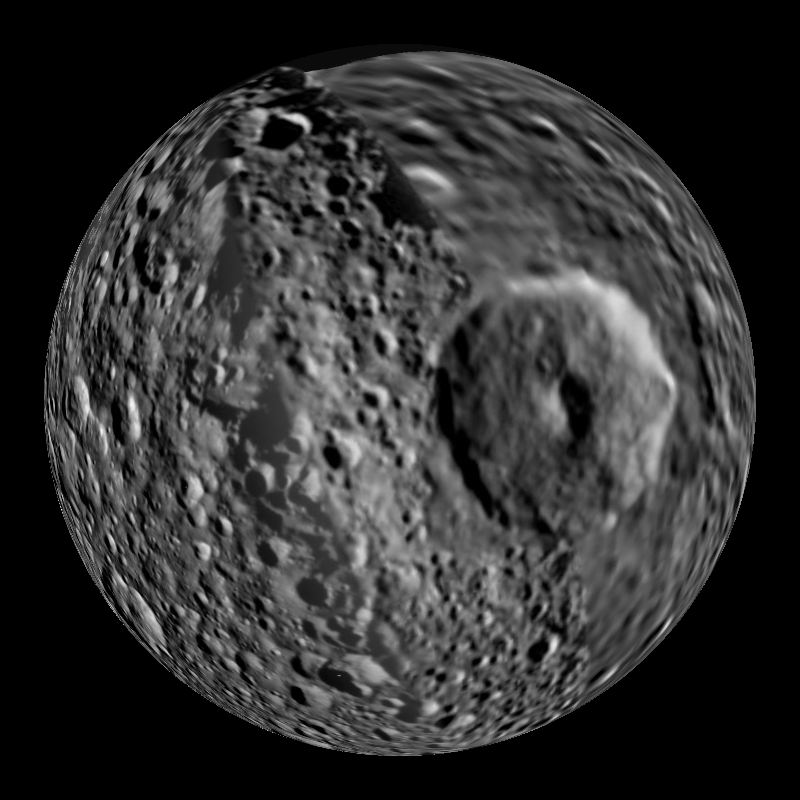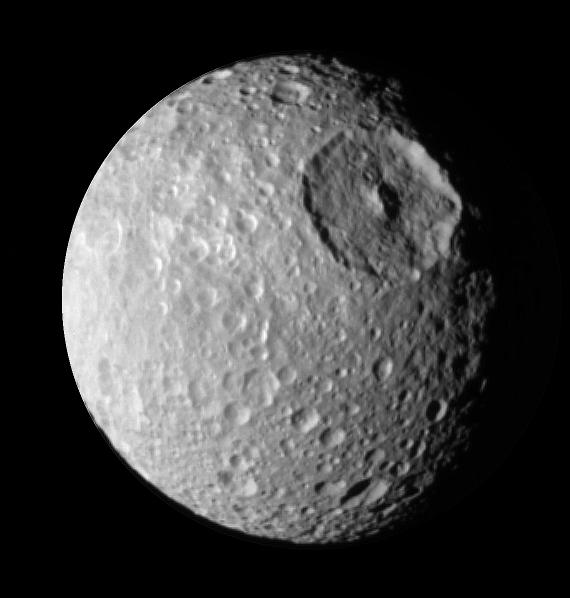Page 1 of 1
APOD: Lutetia: The Largest Asteroid Yet... (2010 Jul 26)
Posted: Mon Jul 26, 2010 4:07 am
by APOD Robot
 Lutetia: The Largest Asteroid Yet Visited
Explanation:
Lutetia: The Largest Asteroid Yet Visited
Explanation: As humans explore the universe, the record for largest asteroid visited by a spacecraft has increased yet again. Earlier this month, ESA's robotic
Rosetta spacecraft zipped past the asteroid 21 Lutetia
taking data and snapping images in an effort to better determine the history of the asteroid and the origin of its
unusual colors. Although of unknown composition,
Lutetia is not massive enough for gravity to pull it into a sphere.
Pictured above on the upper right, the 100-kilometer across
Lutetia is shown in comparison with the other nine asteroids and four comets that have been visited, so far, by human-launched spacecraft. Orbiting in the main asteroid belt,
Lutetia shows itself to be a heavily cratered remnant of the early Solar System. The
Rosetta spacecraft is
now continuing onto
comet Churyumov-Gerasimenko where a landing is planned for 2014.
[/b]
Re: APOD: Lutetia: The Largest Asteroid Yet... (2010 Jul 26)
Posted: Mon Jul 26, 2010 6:03 am
by arturo
i agree with the theory that lutetia and other asteriods were part or belongs to early solar system.
however, i just have an inquiry, what is the image of our planet earth without liquid and gas particles such as water? will this be similar to an asteriods? if necessary, would you published in APOD the artist perception of the planet earth without water? thanks, i'm a daily visitor of apod here in nueva ecija, phlippines.
Re: APOD: Lutetia: The Largest Asteroid Yet... (2010 Jul 26)
Posted: Mon Jul 26, 2010 8:03 am
by agulesin
"by human-launched spacecraft"...
Didn't know that there were any other spacecraft out there... Interesting!!

Re: APOD: Lutetia: The Largest Asteroid Yet... (2010 Jul 26)
Posted: Mon Jul 26, 2010 11:36 am
by orin stepanek
The asteroid belt a rock collector's paradise.

When Vesta is visited; that will be the largest! Ceres being a dwarf planet.

Re: APOD: Lutetia: The Largest Asteroid Yet... (2010 Jul 26)
Posted: Mon Jul 26, 2010 12:14 pm
by thesach
As a daily reader of APOD, I want to thank you for such an informative picture with the specific dimensions included. Great summary.
Re: APOD: Lutetia: The Largest Asteroid Yet... (2010 Jul 26)
Posted: Mon Jul 26, 2010 1:09 pm
by León
Lutetia is a M-type asteroid in the asteroid belt, about 100 km in diameter. Lutetia is the Latin name for Paris. It was discovered on November 15, 1852 by Hermann Mayer Salomon Goldschmidt from the balcony of his apartment in Paris.
The size of the craters is presumed that belonged to a larger body, the composition of iron would indicate it is the core of a planet subjected to a barrage severe as to leave traces in the material so hard to be lacking determine whether it was started by an impact or dynamic imbalance.
Re: APOD: Lutetia: The Largest Asteroid Yet... (2010 Jul 26)
Posted: Mon Jul 26, 2010 1:44 pm
by neufer
orin stepanek wrote:
The asteroid belt a rock collector's paradise.

When Vesta is visited; that will be the largest! Ceres being a dwarf planet.

Code: Select all
characteristics Ida Mathilde Lutetia Vesta Ceres
----------------------------------------------------------------------
Radius (km) 15.7 26.4 47.9 264.5 487.3
Mass (10^16 kg) 4.2 10.3 257.0 2670.0 9430.0
Density (g/cm³) 2.6 1.3 5.55 3.42 2.08
Rotation (days) 0.193 17.4 0.340 0.222 0.378
Albedo 0.238 0.044 0.208 0.423 0.090
Temperature (K) 200 174 266 255 167
Abs. magnitude 9.94 10.20 7.29 3.20 3.36
SM axis (AU) 2.86 2.65 2.44 2.36 2.77
Eccentricity 0.045 0.266 0.164 0.089 0.079
Inclination 1.1° 6.7° 3.1° 7.1° 10.6°
Dark, fluffy and slow:
1) Mathilde has only about one tenth the albedo of Vesta.
Mathilde is 4 times less denser & rotates 90 times slower than Ida.
Re: APOD: Lutetia: The Largest Asteroid Yet... (2010 Jul 26)
Posted: Mon Jul 26, 2010 1:50 pm
by bystander
Re: APOD: Lutetia: The Largest Asteroid Yet... (2010 Jul 26)
Posted: Mon Jul 26, 2010 2:55 pm
by Chris Peterson
León wrote:The size of the craters is presumed that belonged to a larger body, the composition of iron would indicate it is the core of a planet subjected to a barrage severe as to leave traces in the material so hard to be lacking determine whether it was started by an impact or dynamic imbalance.
It is a discredited theory that the asteroids were produced by the destruction of a planet. They were formed from the same ingredients as the terrestrial planets, but in a zone that did not allow a planet to condense. Larger asteroids (tens of kilometers and more) retained enough heat, and produced it from radioactive decay, to allow differentiation- iron had time to sink to the core. The largest bodies that ever existed in the region of the asteroids were probably just planetesimals.
Re: APOD: Lutetia: The Largest Asteroid Yet... (2010 Jul 26)
Posted: Mon Jul 26, 2010 5:11 pm
by BMAONE23
arturo wrote:i agree with the theory that lutetia and other asteriods were part or belongs to early solar system.
however, i just have an inquiry, what is the image of our planet earth without liquid and gas particles such as water? will this be similar to an asteriods? if necessary, would you published in APOD the artist perception of the planet earth without water? thanks, i'm a daily visitor of apod here in nueva ecija, phlippines.
This
YouTube vid shows some of what is beneath the surface. If you were to deplete the atmosphere and oceans on Earth, It would appear similar to Mars in that it would still be Round. It would have similarities to IO beacuse there would still be active Vulcanism especially along the Mid Atlantic Ridge and Pacific Subduction zones. Given all the volcanic activity, It could eventually resemble Venus given Its gravity and Volcanic activity dumping massive ammounts of CO2/CH4/SO2 to replinish the atmosphere. But it would still be unlike anyplace else in the Solar System.
Re: APOD: Lutetia: The Largest Asteroid Yet... (2010 Jul 26)
Posted: Mon Jul 26, 2010 8:13 pm
by cadmiumyel
Where is Itokawa?
Re: APOD: Lutetia: The Largest Asteroid Yet... (2010 Jul 26)
Posted: Mon Jul 26, 2010 8:23 pm
by bystander
Re: APOD: Lutetia: The Largest Asteroid Yet... (2010 Jul 26)
Posted: Tue Jul 27, 2010 4:30 am
by BMAONE23
cadmiumyel wrote:Where is Itokawa?
Itokawa is that little speck of white above the "I" in it's name. Click on and open the gigantic image and Itokawa will appear large enough to see.
The problem is that Lutetia is so comparitively enormous next to it, Itokawa practically vanishes
Re: APOD: Lutetia: The Largest Asteroid Yet... (2010 Jul 26)
Posted: Tue Jul 27, 2010 6:49 am
by Ann
Hmmm, I think Lutetia looks like a lady in profile, looking left, her nose jutting out to the left, and her hair put up in an intricate hairdo on the right side of the asteroid!
Otherwise, what I think is most interesting about this composite of different-sized asteroids is that it reminds me of Mimas, one of the moons of Saturn. MImas is very interesting when it comes to the size and shape of small rocky bodies in our solar system. According to Wikipedia,
Mimas is the smallest known astronomical body that is thought to be rounded in shape due to self-gravitation.
This is the size of Mimas: 414.8×394.4×381.4 km
Here is an image of Mimas:

This is the best-known picture of Mimas, really showing off the big crater, Herschel (as I think it is called):

Ann
Re: APOD: Lutetia: The Largest Asteroid Yet... (2010 Jul 26)
Posted: Tue Jul 27, 2010 12:39 pm
by León
Chris Peterson wrote:León wrote:The size of the craters is presumed that belonged to a larger body, the composition of iron would indicate it is the core of a planet subjected to a barrage severe as to leave traces in the material so hard to be lacking determine whether it was started by an impact or dynamic imbalance.
It is a discredited theory that the asteroids were produced by the destruction of a planet. They were formed from the same ingredients as the terrestrial planets, but in a zone that did not allow a planet to condense. Larger asteroids (tens of kilometers and more) retained enough heat, and produced it from radioactive decay, to allow differentiation- iron had time to sink to the core. The largest bodies that ever existed in the region of the asteroids were probably just planetesimals.
The information that the asteroid is part of a larger body of
http://www.esa.int/esaMI/Rosetta/SEM44DZOFBG_0.html take it "These Have Been Associated with iron meteorites, and are reddish Usually Thought to be fragments of the cores of much larger objects "which I believe is a strict information today.
Coincidentally searches are performed in meteorites that meet these characteristics because they provide access to the old maximum planetary components.
Moreover, the asteroid belt is a remnant of something more important, no one can argue that there is all that was.
Besides personally disbelieve of the planetesimals are based generators planets
Re: APOD: Lutetia: The Largest Asteroid Yet... (2010 Jul 26)
Posted: Fri Jul 30, 2010 11:37 am
by harry
G'day
My son says thank you for the info, great link.
 Lutetia: The Largest Asteroid Yet Visited
Lutetia: The Largest Asteroid Yet Visited
